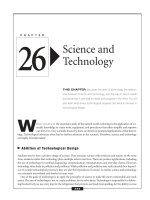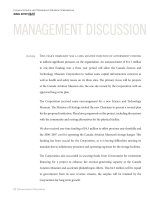3 17 science and its uses (space and technology)
Bạn đang xem bản rút gọn của tài liệu. Xem và tải ngay bản đầy đủ của tài liệu tại đây (3.46 MB, 14 trang )
Genre
Nonfiction
Comprehension Skill
Sequence
Text Features
• Captions
• Labels
• Text Box
• Glossary
Science Content
Technology
Scott Foresman Science 3.17
ISBN 0-328-13857-6
ì<(sk$m)=bdifhj< +^-Ä-U-Ä-U
Vocabulary
What did you learn?
computer
invention
technology
tool
1. What invention changed the way
mail was delivered in the United
States in the 1860s?
2. What technology helps
meteorologists do their job? How?
by Jessica Quilty
3. What is a wind farm?
Picture Credits
Every effort has been made to secure permission and provide appropriate credit for photographic material.
The publisher deeply regrets any omission and pledges to correct errors called to its attention in subsequent editions.
Photo locators denoted as follows: Top (T), Center (C), Bottom (B), Left (L), Right (R), Background (Bkgd).
3 Corbis; 4 Franco Vogt/Corbis; 6 Hulton-Deutsch Collection/Corbis; 7 Getty Images; 10 Getty Images; 12 Getty Images;
14 Kevin Schafer/Corbis; 15 Roy Morsch/Corbis; 16 Getty Images; 18 Ariel Skelley/Corbis; 19 Getty Images; 20 (CR) Getty
Images; 21 (TL) Honda; 22 Getty Images; 23 Getty Images, (BL) Michael A. Keller/Corbis.
Scott Foresman/Dorling Kindersley would also like to thank: 2 Natural History Museum/DK Images; 8 NASA/DK Images.
Unless otherwise acknowledged, all photographs are the copyright © of Dorling Kindersley, a division of Pearson.
ISBN: 0-328-13857-6
Copyright © Pearson Education, Inc. All Rights Reserved. Printed in the United States of America.
This publication is protected by Copyright, and permission should be obtained from the publisher prior to any
prohibited reproduction, storage in a retrieval system, or transmission in any form by any means, electronic,
mechanical, photocopying, recording, or likewise. For information regarding permission(s), write to
Permissions Department, Scott Foresman, 1900 East Lake Avenue, Glenview, Illinois 60025.
3 4 5 6 7 8 9 10 V010 13 12 11 10 09 08 07 06 05
4.
In this book
you have read about computers.
Write to explain how computers are
used today. Include examples from
the book.
5.
Sequence List the steps that
must take place for food from other
countries to reach a grocery store in
the United States.
A hammer is a tool.
Technology
In Our Lives
Ways to Improve
The United States was less than one hundred
years old in the 1860s. Parts of the country still
needed to be explored. Many people moved
westward to do this.
But they still needed to communicate with
people living in the East. People started thinking
about how to do this. How could they
communicate? Would a tool help? Was an
invention needed?
Tools help people do jobs more easily. A tool
can also help people think of new ways of doing
things. Technology is the use of knowledge to
create new tools and new ways of doing things.
2
People decided that an invention was needed
to communicate. An invention is something
created for the first time. The Pony Express was
invented in the 1860s.
The Pony Express used horses and riders
to carry mail across the country. This way,
mail could be delivered between Missouri
and California. Many riders and horses
followed a schedule to move mail
across the country. The invention
of the Pony Express made
it possible for people
living in the West to
communicate with
people living in
the East.
New tools and
technology are
used to communicate
today. Airplanes and
other machines move
mail around the
whole world.
The Pony Express
3
Technology at Home
Many systems work together in your home.
Just think about all the technology at work in
your home every day. Your home is made up
of walls and a roof. The walls are part of the
framing system. The framing system works with
the roofing system to protect your home from
the weather. When you watch TV or play a video
game, the electrical system is at work. When you
wash your hands, the electrical system works
with the plumbing system. These systems work
together to bring you hot, running water.
The electrical system also helps you
communicate. This technology makes
it possible for you to use the telephone
and the Internet.
How many telephones
do you have in your house?
Are the telephones the
same or different?
Some telephones have
cords. Others are
cordless. A cordless
telephone can be
taken all over
your house.
Technology helps
people keep in touch
with each other.
A TV uses electricity.
4
5
Past, Present, And
Future Technologies
Technology has affected many parts of
modern life. Just think about transportation.
Today people use cars. What types of
transportation did people use before there were
cars? A long time ago, people used horses and
buggies to travel. Many people also used trains.
But these types of transportation were slow.
Trains and cars are very fast today. Sometimes
you see superfast trains and cars in movies.
In the 1800s people traveled
using horses and buggies.
6
Camera technology helps produce today’s movies.
People have been enjoying movies for a long
time. Many technologies are used in movies.
Movies today are loud, exciting, and colorful.
But the first moving pictures were silent. They
were also black and white.
Soon, technology made color movies possible.
This was very expensive at first. As technology
improved, more movies were made in color.
Before sound was added, people listened to live
organ music during movies.
7
New Technologies
Extending Our Senses
Many people use technology in their jobs.
Meteorologists are scientists who study the
weather. One tool that helps them do their job
is a weather satellite. Weather satellites orbit
Earth. They have solar panels on them. The
panels make power, so the satellites can take
pictures or video. Then the satellites send the
pictures or video of clouds, storms, and other
weather back to Earth. There, meteorologists
study the pictures. Then they can tell people
what weather
is coming. It’s
helpful to know
if it’s going to
snow or rain
so you can stay
warm and dry.
Weather satellite
8
It is very difficult to see in the dark. But
special technology makes this possible. People
can use night vision goggles to see in the dark.
These goggles use two different technologies.
One technology uses heat. Objects, such as
people, give off heat. The goggles sense the
heat and create a picture from it. The other
technology uses tiny amounts of light.
People cannot see this light,
but the goggles can detect it.
Then they make an
image from the
light large enough
for people to see.
Night vision goggles help
people to see in the dark.
9
Sorting Information
You have probably noticed that computers are
everywhere! A computer stores, processes, and
sends electronic information really quickly.
Computers make many parts of daily life easier.
People use computers to sort and organize all
kinds of information. You may use a computer
to do your homework. Your school may use a
computer to keep track of your grades. Your
doctor may use a computer to record any
sicknesses you have had.
MP3 players
use computer
chips. They
allow people to
download music
from a computer.
Many people use computers at work.
Computer chips are used in many objects too.
These tiny chips are found in MP3 players.
People must use a computer to put music onto
an MP3 player. Then they can take music with
them wherever they go. The small player can hold
hours of music. The computer chip inside makes
it possible to organize the music. People can sort
the music by their favorite songs, their favorite
musician, or their favorite type of music.
10
11
Technologies for Moving Goods
Roads and highways are used every day. Our
highway system makes it possible for people
to travel. How do you get to school each day?
You may ride a school bus. Or your parents may
drive you. The bus and the car both travel on
roads to reach your school.
People and goods travel on
highways and on water.
Millions of products travel
on our roads and highways too.
Some of the food found in
Groceries can come
grocery stores comes from
from far away.
far away. Sometimes people load
food onto trucks at a farm. Other times people
load it onto ships in other countries first. Then
the food is loaded onto trucks. The trucks travel
on highways to the grocery stores. Then people
unload it. Finally, the food is put out in the store
for people to buy.
12
13
Surprise Discoveries
Sometimes scientists and inventors are
surprised by their results. Once in a while the
results led to an unexpected discovery or new
technology. Did you know bubblegum was
a surprise discovery?
In 1869, Thomas Adams invented chewing
gum. He made it out of a substance called
chicle. Adams tried to use chicle to make many
different things. He even tried to make bicycle
tires out of it. Chewing gum became very
popular. Many companies started making it.
You could not blow bubbles
with it though.
Chicle is sap from the sapodilla tree.
14
Walter E. Diemer
worked for a chewing
gum company called
Fleer. Diemer was a
businessman. But he
liked experimenting
with chewing gum
recipes at home. In
1928, while working
on a new recipe for
chewing gum, he
accidentally created
a gum that stretched.
Diemer realized he
Bubblegum
could even blow
bubbles with it! This discovery became known
as bubblegum. The first batch was pink because
that was the only food coloring Diemer had.
Most bubblegum today is still pink! For anyone
who loves to chew gum and blow bubbles, this
was a great surprise discovery.
15
Technology
And Energy
For centuries people have burned wood to
create heat for cooking and warmth. Although
most people today use electricity for these things,
many still burn wood when camping.
Today coal, oil, and natural gas are burned to
make heat and electricity. Dead trees, sawdust,
and even paper products that cannot be recycled
again can also be burned. This creates heat that
can be used to make electricity.
Families cook on open fires when camping.
Using Energy
Think about how easy it is to use electricity
today. If you need to use an electrical appliance,
all you have to do is plug it into an electrical
outlet. Then the energy is supplied. If you need
to do some homework on a computer, all you
need to do is turn the computer on. But it has
not always been that easy.
16
17
Producing Electricity
The resources of wind and water were used
in the past to create energy. These resources
are still used today, but in much different ways.
In the past, a farmer often had one windmill on
a farm. It used wind energy to do simple things,
such as pump water. Today there are giant wind
farms with lots of windmills.
These new windmills use wind
energy to create electricity.
Wind farms produce energy.
Waterpower is used to make energy.
People have been using the power of rushing
water for a very long time. In the past, rushing
water turned waterwheels. The waterwheels
could power things, such as saws in lumber mills.
Today, giant hydroelectric power dams are built
to block river water. This water can be released.
The rushing water turns modern waterwheels
that make energy. Then this energy can be turned
into electricity.
18
19
Technology and Energy
Production
New technologies such as wind farms and
hydroelectric power dams are very exciting. But
they are also very expensive. Often, they do not
create enough power and electricity for everyone
to use. This means we still need to burn fossil
fuels, such as coal or oil, at power plants. Burning
these resources is less expensive and creates lots
of power and electricity. However, burning fossil
fuels also creates more pollution than many of
the newer technologies.
20
Power Plant
Hydroelectric Dam
• less expensive
• more expensive
• creates lots of
power
• does not create as
much power
• can pollute the
environment more
• can pollute the
environment less
This hybrid car uses less gas and creates less pollution.
Scientists and inventors are working hard to
find ways of creating power and electricity that
are inexpensive, make enough electricity for
everyone, and pollute the environment less. A
car is a good example.
For a long time, most cars only used
gasoline. But burning gasoline pollutes the
environment. Today there are cars that use
both gasoline and electricity. These cars are
called hybrids. Some of the time they use
gasoline, but other times they use electricity
and create less pollution.
21
Why Is technology
important?
The role technology plays in changing our
world is very important. Technology can be as
simple as a hammer, or as complicated as a
weather satellite.
The Pony Express made communication
possible over long distances in the 1860s. Today
technology in our home keeps us safe from
weather, provides hot, running water, and helps
us communicate. Technology has changed
transportation in many ways. We have gone
from horses and buggies to hybrid cars.
22
Technology has even improved entertainment.
Movies today are amazing to watch because of
sound, color, and special effects. Computers and
computer chips have made MP3 players possible.
All kinds of technologies are important!
MP3 players use
computer chips to
store information.
23
Vocabulary
Glossary
computer
invention
computer
an electronic machine that
technology can store, recall, or process
tool
information
invention
something made for the first time
technology
the use of knowledge to design
new tools and new ways of
doing things
tool
1. What invention changed the way
mail was delivered in the United
States in the 1860s?
2. What technology helps
meteorologists do their job? How?
3. What is a wind farm?
4.
In this book
you have read about computers.
Write to explain how computers are
used today. Include examples from
the book.
5.
Sequence List the steps that
must take place for food from other
countries to reach a grocery store in
the United States.
something used to do work
Picture Credits
Every effort has been made to secure permission and provide appropriate credit for photographic material.
The publisher deeply regrets any omission and pledges to correct errors called to its attention in subsequent editions.
Photo locators denoted as follows: Top (T), Center (C), Bottom (B), Left (L), Right (R), Background (Bkgd).
3 Corbis; 4 Franco Vogt/Corbis; 6 Hulton-Deutsch Collection/Corbis; 7 Getty Images; 10 Getty Images; 12 Getty Images;
14 Kevin Schafer/Corbis; 15 Roy Morsch/Corbis; 16 Getty Images; 18 Ariel Skelley/Corbis; 19 Getty Images; 20 (CR) Getty
Images; 21 (TL) Honda; 22 Getty Images; 23 Getty Images, (BL) Michael A. Keller/Corbis.
Scott Foresman/Dorling Kindersley would also like to thank: 2 Natural History Museum/DK Images; 8 NASA/DK Images.
Unless otherwise acknowledged, all photographs are the copyright © of Dorling Kindersley, a division of Pearson.
ISBN: 0-328-13857-6
Copyright © Pearson Education, Inc. All Rights Reserved. Printed in the United States of America.
This publication is protected by Copyright, and permission should be obtained from the publisher prior to any
prohibited reproduction, storage in a retrieval system, or transmission in any form by any means, electronic,
mechanical, photocopying, recording, or likewise. For information regarding permission(s), write to
Permissions Department, Scott Foresman, 1900 East Lake Avenue, Glenview, Illinois 60025.
24
What did you learn?
3 4 5 6 7 8 9 10 V010 13 12 11 10 09 08 07 06 05









